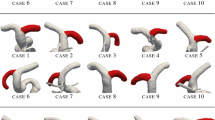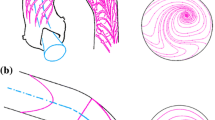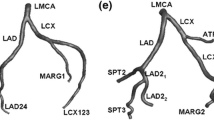Abstract
The rationale for this study lies in the well-known predilection for vascular disease of the carotid bifurcation, attributed to an altered shear stress distribution at the luminal surface and mitigated by helical fluid structures establishing inside the bifurcation. Here we investigate the mechanistic role played by the common carotid artery (CCA) in promoting complex intravascular flow and in influencing the hemodynamics at the distal carotid bifurcation. Fifty-five image-based computational hemodynamic models of eleven right carotid geometries were reconstructed from its brachiocephalic origin to above the bifurcation to assess how five different CCA reconstruction length affects intravascular fluid structures entering the bifurcation. A quantitative description of helical flow is adopted, in parallel to the description of disturbed shear at the bifurcation luminal surface. Our findings support the hypothesis that helical flow in CCA might reduce the likelihood of flow disturbances at the bifurcation. This confirms the physiological role of CCA in transporting and enforcing helical flow structures into the bifurcation, giving further contribution to the helicity-driven suppression of disturbed shear. A quantitative analysis of CCA geometry highlights the beneficial effect of proximal CCA curvature on helical flow and shows the complex interlacement among CCA geometry, helical flow, and disturbed shear at the bifurcation. Since helicity-based descriptors and geometric descriptors relative to the bifurcation have been shown to be significant predictors of disturbed shear, in principle they may be augmented by factors related to CCA geometry and hemodynamics.





Similar content being viewed by others
References
Alastruey, J., J. H. Siggers, V. Peiffer, D. J. Doorly, and S. J. Sherwin. Reducing the data: analysis of the role of vascular geometry on blood flow patterns in curved vessels. Phys. Fluids 24:031902, 2012.
Aristokleous, N., I. Seimenis, G. C. Georgiou, Y. Papaharilaou, B. C. Brott, A. Nicolaides, and A. S. Anayiotos. Impact of head rotation on the individualized common carotid flow and carotid bifurcation hemodynamics. IEEE J. Biomed. Health Inform. 18(3):783–789, 2014.
Balbi, S., S. Roatta, and C. Guiot. Curvature affects Doppler investigation of vessels: implication for clinical practice. Ultrasound Med. Biol. 31:65–77, 2005.
Bijari, P. B., L. Antiga, D. Gallo, B. A. Wasserman, and D. A. Steinman. Improved prediction of disturbed flow via hemodynamically-inspired geometric variables. J. Biomech. 45:1632–1637, 2012.
Boussel, L., A. Serusclat, M. R. Skilton, F. Vincent, S. Bernard, P. Moulin, D. Saloner, and P. C. Douek. The reliability of high resolution MRI in the measurement of early stage carotid wall thickening. J. Cardiovasc. Magn. Reson. 9:771–779, 2007.
Caro, C. G., C. L. Dumoulin, J. M. Graham, K. H. Parker, and S. P. Souza. Secondary flow in the human common carotid artery imaged by MR angiography. J. Biomech. Eng. 114(1):147–149, 1992.
Caro, C. G., D. J. Doorly, M. Tarnawski, K. T. Scott, Q. Long, and C. L. Dumoulin. Non-planar curvature and branching of arteries and non-planar-type flow. Proc. R Soc. Lond. A 452:185–197, 1996.
Dean, W. R. Fluid motion in a curved channel. Proc. Roy. Soc. A 121:402–420, 1927.
Ford, M. D., Y. J. Xie, B. A. Wasserman, and D. A. Steinman. Is flow in the common carotid artery fully developed? Physiol. Meas. 29(11):1335–1349, 2008.
Gallo, D., D. A. Steinman, P. B. Bijari, and U. Morbiducci. Helical flow in carotid bifurcation as surrogate marker of exposure to disturbed shear. J. Biomech. 45:2398–2404, 2012.
Germano, M. On the effect of torsion on flow. J. Fluid Mech. 125:1–8, 1982.
Germano, M. The Dean equations extended to a helical pipe flow. J. Fluid Mech. 203:289–305, 1989.
Himburg, H. A., D. M. Grzybowski, A. Hazel, J. A. LaMack, X. M. Li, and M. H. Friedman. Spatial comparison between wall shear stress measures and porcine arterial endothelial permeability. Am. J. Physiol. Heart Circ. Physiol. 286(5):H1916–H1922, 2004.
Hoi, Y., B. A. Wasserman, E. G. Lakatta, and D. A. Steinman. Effect of common carotid artery inlet length on normal carotid bifurcation hemodynamics. J. Biomech. Eng. 132:121008, 2010.
Ku, D. N., D. P. Giddens, C. K. Zarins, and S. Glagov. Pulsatile flow and atherosclerosis in the human carotid bifurcation. Positive correlation between plaque location and low and oscillating shear stress. Arteriosclerosis 5(3):293–302, 1985.
Lee, S. W., and D. A. Steinman. On the relative importance of rheology for image-based CFD models of the carotid bifurcation. J. Biomech. Eng. 129(2):273–278, 2007.
Lee, S. W., L. Antiga, J. D. Spence, and D. A. Steinman. Geometry of the carotid bifurcation predicts its exposure to disturbed flow. Stroke 39(8):2341–2347, 2008.
Lee, S. W., L. Antiga, and D. A. Steinman. Correlations among indicators of disturbed flow at the normal carotid bifurcation. J. Biomech. Eng. 131(6):061013, 2009.
Liu, S., and J. H. Masliyah. Axially invariant laminar flow in helical pipes with a finite pitch. J. Fluid Mech. 251:315–353, 1993.
Liu, X., F. Pu, Y. Fan, X. Deng, D. Li, and S. Li. A numerical study on the flow of blood and the transport of LDL in the human aorta: the physiological significance of the helical flow in the aortic arch. Am. J. Physiol. Heart Circ. Physiol. 297:H163–H170, 2009.
Liu, X., Y. Fan, and X. Deng. Effect of spiral flow on the transport of oxygen in the aorta: a numerical study. Ann. Biomed. Eng. 38(3):917–926, 2010.
Malek, A. M., S. L. Alper, and S. Izumo. Hemodynamic shear stress and its role in atherosclerosis. JAMA 282:2035–2042, 1999.
Manbachi, A., Y. Hoi, B. A. Wasserman, E. G. Lakatta, and D. A. Steinman. On the shape of the common carotid artery, with implications for blood velocity profiles. Physiol. Meas. 32(12):1885–1897, 2011.
Marzo, A., P. Singh, P. Reymond, N. Stergiopulos, U. Patel, and R. Hose. Influence of inlet boundary conditions on the local hemodynamics of intracranial aneurysms. Comput. Methods Biomech. Biomed. Eng. 12(4):431–444, 2009.
Minev, P. D., and C. R. Ethier. A characteristic/finite element algorithm for the 3-D Navier-Stokes equations using unstructured grids. Comput. Methods Appl. Mech. Eng. 178:39–50, 1998.
Moffatt, H. K. The degree of knottedness of tangled vortex lines. J. Fluid Mech. 35(1):17–29, 1969.
Moffatt, H. K., and A. Tsinober. Helicity in laminar and turbulent flow. Annu. Rev. Fluid Mech. 24:281–312, 1992.
Morbiducci, U., R. Ponzini, M. Grigioni, and A. Redaelli. Helical flow as fluid dynamic signature for atherogenesis in aortocoronary bypass. A numeric study. J. Biomech. 40:519–534, 2007.
Morbiducci, U., D. Gallo, R. Ponzini, D. Massai, L. Antiga, A. Redaelli, and F. M. Montevecchi. Quantitative analysis of bulk flow in image-based haemodynamic models of the carotid bifurcation: the influence of outflow conditions as test case. Ann. Biomed. Eng. 38(12):3688–3705, 2010.
Morbiducci, U., D. Gallo, D. Massai, R. Ponzini, M. A. Deriu, L. Antiga, A. Redaelli, and F. M. Montevecchi. On the importance of blood rheology for bulk flow in hemodynamic models of the carotid bifurcation. J. Biomech. 44:2427–2438, 2011.
Morbiducci, U., R. Ponzini, G. Rizzo, M. Cadioli, A. Esposito, F. M. Montevecchi, and A. Redaelli. Mechanistic insight into the physiological relevance of helical blood flow in the human aorta: an in vivo study. Biomech. Model. Mechanobiol. 10:339–355, 2011.
Morbiducci, U., R. Ponzini, D. Gallo, C. Bignardi, and G. Rizzo. Inflow boundary conditions for image-based computational hemodynamics: impact of idealized versus measured velocity profiles in human aorta. J. Biomech. 46(1):102–109, 2013.
Moyle, K. R., L. Antiga, and D. A. Steinman. Inlet conditions for image-based CFD models of the carotid bifurcation: is it reasonable to assume fully developed flow? J. Biomech. Eng. 128(3):371–379, 2006.
Myers, J. G., J. A. Moore, M. Ohja, K. W. Johnston, and C. R. Ethier. Factors influencing blood flow patterns in human right coronary artery. Ann. Biomed. Eng. 29(2):109–120, 2001.
Mynard, J. P., B. A. Wasserman, and D. A. Steinman. Errors in the estimation of wall shear stress by maximum Doppler velocity. Atherosclerosis 227(2):259–266, 2013.
Pantos, J., E. Efstathopoulos, and D. G. Katritsis. Vascular wall shear stress in clinical practice. Curr. Vasc. Pharmacol. 5:113–119, 2007.
Papaharilaou, Y., N. Aristokleous, I. Seimenis, M. I. Khozeymeh, G. C. Georgiou, B. C. Briott, E. Eracleous, and A. S. Anayiotos. Effect of head posture on the healthy human carotid bifurcation hemodynamics. Med. Biol. Eng. Comput. 51(1–2):207–218, 2013.
Perktold, K., E. Thurner, and T. Kenner. Flow and stress characteristics in rigid walled and compliant carotid artery bifurcation models. Med. Biol. Eng. Comput. 32(1):19–26, 1994.
Ponzini, R., C. Vergara, G. Rizzo, A. Veneziani, A. Roghi, A. Vanzulli, O. Parodi, and A. Redaelli. Womersley number-based estimates of blood flow rate in Doppler analysis: in vivo validation by means of phase-contrast MRI. IEEE Trans. Biomed. Eng. 57(7):1807–1815, 2010.
Sangalli, L. M., P. Secchi, S. Vantini, and A. Veneziani. Efficient estimation of three-dimensional curves and their derivatives by free-knot regression splines, applied to the analysis of inner carotid artery centrelines. Appl. Statist. 58(3):285–306, 2009.
Sluimer, J. C., J. M. Gasc, J. L. van Wanroij, N. Kisters, M. Groeneweg, M. D. Sollewijn Gelpke, J. P. Cleutjens, L. H. van den Akker, P. Corvol, B. G. Wouters, M. J. Daemen, and A. P. Bijnens. Hypoxia, hypoxia-inducible transcription factor, and macrophages in human atherosclerotic plaques are correlated with intraplaque angiogenesis. J. Am. Coll. Cardiol. 51:1258–1265, 2008.
Stonebridge, P. A., P. R. Hoskins, P. L. Allan, and J. F. Belch. Spiral laminar flow in vivo. Clin. Sci. (Lond.) 91:17–21, 1996.
Thomas, J. B., L. Antiga, S. L. Che, J. S. Milner, D. A. Hangan-Steinman, J. D. Spence, B. K. Rutt, and D. A. Steinman. Variation in the carotid bifurcation geometry of young versus older adults: implications for geometric risk of atherosclerosis. Stroke 36:2450–2456, 2005.
Tortoli, P., V. Michelassi, G. Bambi, F. Guidi, and D. Righi. Interaction between secondary velocities, flow pulsation and vessel morphology in the common carotid artery. Ultrasound Med. Biol. 29:407–415, 2003.
Wake, A. K., J. N. Oshinski, A. R. Tannenbaum, and D. P. Giddens. Choice of in vivo versus idealized velocity boundary conditions influences physiologically relevant flow patterns in a subject-specific simulation of flow in the human carotid bifurcation. J. Biomech. Eng. 131(2):021013, 2009.
Zhou, S., and X. Shen. Spatially adaptive regression splines and accurate knot selection schemes. JASA 96(453):247–259, 2001.
Conflict of interest
All authors declare that they have no financial and personal relationships with other people or organizations that could have inappropriately influenced (biased) the submitted work.
Author information
Authors and Affiliations
Corresponding author
Additional information
Associate Editor Andreas Anayiotos oversaw the review of this article.
Electronic supplementary material
Below is the link to the electronic supplementary material.
Rights and permissions
About this article
Cite this article
Gallo, D., Steinman, D.A. & Morbiducci, U. An Insight into the Mechanistic Role of the Common Carotid Artery on the Hemodynamics at the Carotid Bifurcation. Ann Biomed Eng 43, 68–81 (2015). https://doi.org/10.1007/s10439-014-1119-0
Received:
Accepted:
Published:
Issue Date:
DOI: https://doi.org/10.1007/s10439-014-1119-0




